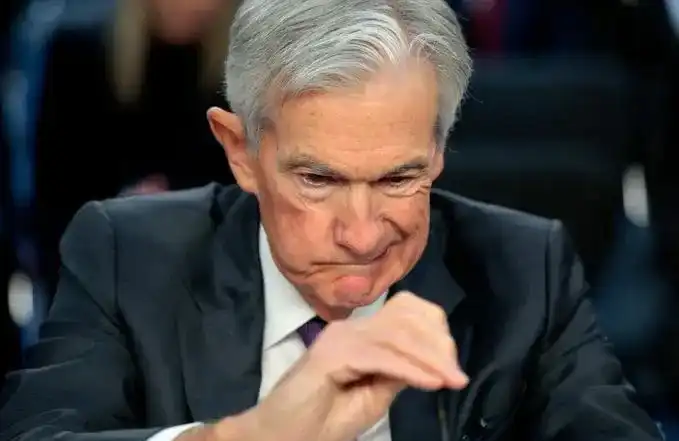The last time a U.S. president exerted such pressure on the Federal Reserve was in 1971 with Nixon, and two years later the U.S. entered a period of stagflation.
Original Article Title: "The Last Time a U.S. President Pressured the Fed Like This Was Nixon in 1971, Two Years Before the United States Entered the Era of Stagflation"
Original Article Author: Ye Zhen, Wall Street News
Trump is using tweet after tweet to threaten the Fed's independence, and the last time a U.S. president pressured the Fed like this was in 1971, on the eve of the United States' Great Stagflation.
In 1971, the U.S. economy was already facing a "stagflation" dilemma, with an unemployment rate of 6.1%, an inflation rate exceeding 5.8%, and a continued expansion of the trade deficit. In order to seek re-election, President Nixon exerted unprecedented pressure on then Fed Chairman Burns.
White House records show that in 1971, Nixon's interactions with Burns significantly increased, especially in the third and fourth quarters of 1971, with formal meetings between the two reaching 17 times per quarter, far exceeding the usual communication frequency.
This intervention manifested at the policy operations level as follows: in that year, the U.S. federal funds rate plummeted from 5% at the beginning of the year to 3.5% at year-end, and the M1 money supply growth rate reached a post-World War II peak of 8.4%. In the year of the Bretton Woods system's collapse and the dramatic transformation of the global monetary system, Burns' political compromises laid the groundwork for the later "Great Inflation," which was only resolved after Paul Volcker significantly raised interest rates beginning in 1979.
As a result, Burns carried the historical stigma. Today's Powell has no intention of repeating Burns' fate.
Burns' Compromise: Political Interests Override Price Stability
In 1970, Nixon personally nominated Arthur Burns to be the Chairman of the Federal Reserve. Burns was an economist at Columbia University and had been Nixon's economic advisor during the campaign, and the two were very close. Nixon had high hopes for Burns—not as a guardian of monetary policy, but as a "cooperator" in political strategy.
At the time, Nixon faced immense pressure to win re-election in 1972, and the U.S. economy had not fully recovered from the recession of 1969, with high unemployment rates. He desperately needed a wave of economic growth, even if it was a false prosperity created through "easy money."
Therefore, he repeatedly pressured Burns, hoping the Fed would cut interest rates and increase money supply to stimulate growth. The White House's internal recordings captured multiple conversations between Nixon and Burns.
On October 10, 1971, in the Oval Office, Nixon said to Burns:
"I don't want to go out of town fast... If we lose, this will be the last time a conservative is in Washington."
He suggested that if he failed to be re-elected, Burns would face a future dominated by Democrats, and the political atmosphere would change drastically. Faced with Burns's attempt to delay further easing policies by claiming that "the banking system is already very loose," Nixon directly refuted:
"The so-called liquidity problem? That's just bullshit."
Shortly after, in a phone call, Burns reported to Nixon, "We have lowered the discount rate to 4.5%."
Nixon responded:
"Good, good, good... You can lead 'em. You always have. Just kick 'em in the rump a little."
Not only did Nixon pressure Burns on policy, but he also made his stance clear on personnel arrangements. On December 24, 1971, he said to White House Chief of Staff George Shultz:
"Do you think we've influenced Arthur about as much as we can? I mean, how much can I put the screws to him?"
"If not, I'll bring him in."
Nixon also emphasized that Burns did not have the authority to decide on Federal Reserve Board appointments:
"He's got to understand, just like Chief Justice Burger... I'm not going to let him name his people."
These dialogues are from White House recordings, clearly showing the U.S. President's systematic pressure on the Fed Chairman. And Burns indeed "complied" and defended his actions with a set of theories.
He believed that a tight monetary policy and the consequent rise in unemployment were ineffective in curbing the inflation at the time, as the root of inflation lay in factors beyond the Fed's control, such as unions, food and energy shortages, and OPEC's control of oil prices.
From 1971 to 1972, the Fed lowered interest rates, expanded the money supply, and drove a brief economic boom, which also helped Nixon achieve his re-election goal. However, the cost of this "artificially created" economic prosperity soon became apparent.
Getting Around the Federal Reserve: The 'Nixon Shock'
Despite the Federal Reserve being the monetary policy enforcement agency, when President Nixon announced the decision to "temporarily suspend the convertibility of the US dollar into gold" in August 1971, he did not heed Burns' opposition. From August 13-15, 1971, Nixon convened a closed-door meeting with 15 key advisors at Camp David, including Burns, Treasury Secretary Connally, and then-Under Secretary of the Treasury for International Monetary Affairs Volcker.
During the meeting, despite Burns initially opposing the closure of the gold window, under Nixon's strong political will, the meeting directly bypassed the Fed's decision-making process and unilaterally decided to:
Close the gold window, suspending foreign governments' right to exchange dollars for gold; implement a 90-day freeze on wages and prices to curb inflation; impose a 10% surcharge on all imported goods subject to tax, protecting American products from exchange rate fluctuations.
This series of measures, known as the 'Nixon Shock,' shattered the foundation of the Bretton Woods system established in 1944, causing a surge in gold prices and the disintegration of the global exchange rate system.
Initially, wage and price controls temporarily suppressed inflation, with US inflation kept at 3.3% in 1972. However, by 1973, Nixon lifted price controls, and at this point, the consequences of excessive dollar circulation and supply-demand imbalance quickly became apparent. Coupled with the first oil crisis that same year, prices began to soar.
The US economy then fell into a rare 'stagflation' situation, with the inflation rate reaching 8.8% in 1973 and soaring to 12.3% in 1974, while unemployment continued to rise, forming a typical stagnation-inflation pattern.
At this time, Burns attempted to tighten monetary policy, only to find that he had already lost credibility. His reliance on political compromises and non-monetary measures laid the groundwork for 'Great Inflation,' until Paul Volcker took office in 1979 and thoroughly 'suppressed' inflation with an extreme tightening policy, thereby restoring the Fed's independent prestige.
Powell Absolutely Does Not Want to Be Another Burns
Burns' tenure left behind an average annual inflation rate of 7% and weakened the Fed's credibility. Internal Federal Reserve documents and Nixon's recordings show that Burns placed short-term political needs above long-term price stability, making his tenure a textbook example of central bank independence being undermined.
Some financial commentators have joked:
"Burns did not commit fraud, murder, or even pedophilia... His only crime was—cutting interest rates before inflation was fully under control."
In contrast, Volcker's successor, Paul Volcker, "choked" inflation with a 19% interest rate, causing a severe recession but emerging as the hero who slayed inflation in the eyes of Wall Street, economic history, and the public. History has shown that Americans can forgive a Federal Reserve chair who leads the economy into a recession, but they will not forgive a chair who ignites inflation.
Powell is well aware of this and has no intention of becoming the next Burns.
Welcome to join the official BlockBeats community:
Telegram Subscription Group: https://t.me/theblockbeats
Telegram Discussion Group: https://t.me/BlockBeats_App
Official Twitter Account: https://twitter.com/BlockBeatsAsia
 Forum
Forum OPRR
OPRR Finance
Finance
 Specials
Specials
 On-chain Eco
On-chain Eco
 Entry
Entry
 Podcasts
Podcasts
 Data
Data

 Summarized by AI
Summarized by AI







